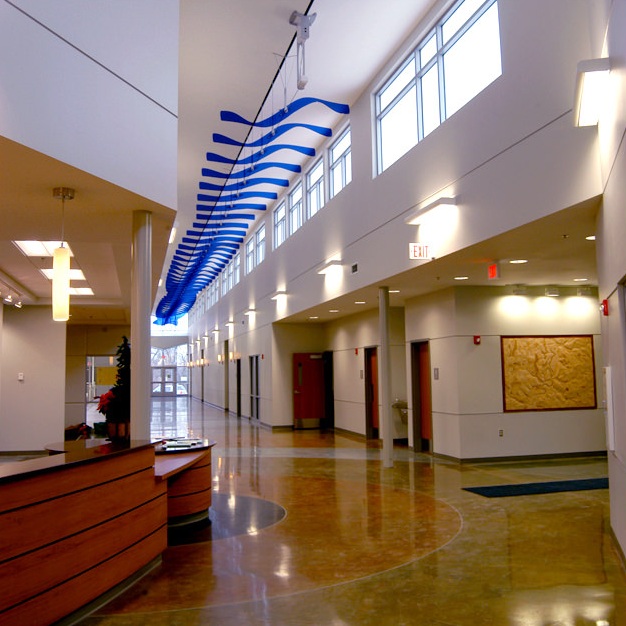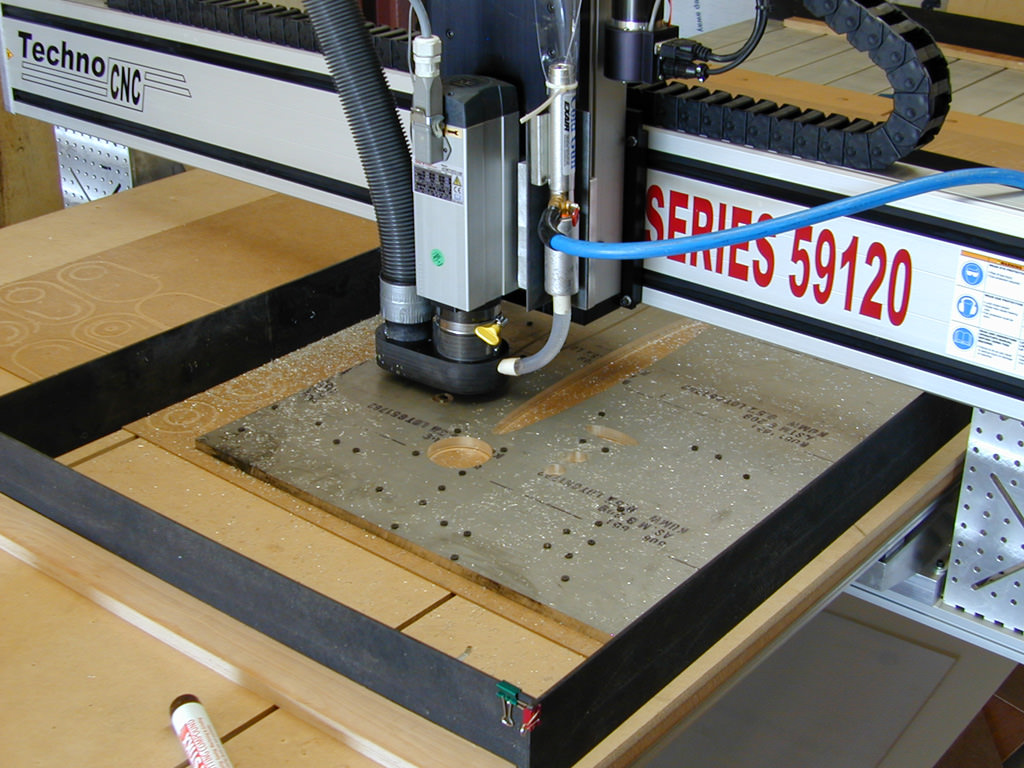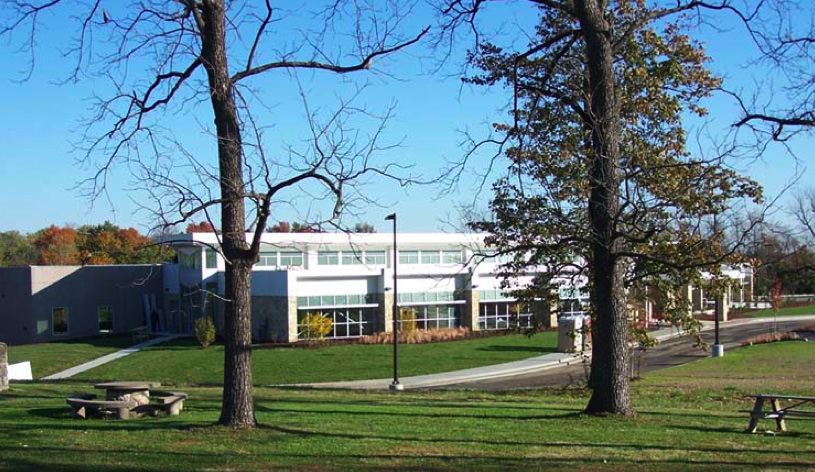
Southeast Community Center, Kansas City, MO :: 2009.
This new building is located on the northern edge of Swope Park in Kansas City. It replaced a small, neglected facility in an historically underserved neighborhood nearby, and was worked hard for and much wanted by its surrounding community.
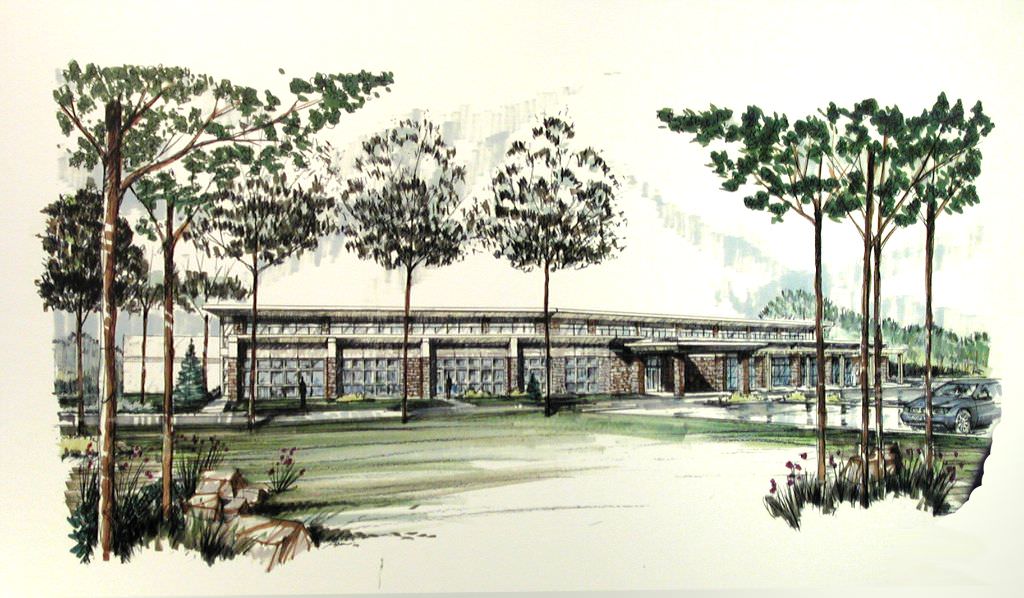
Architect's rendering for the new community center :: 2008.
We were included in the final planning and construction stages of this silver LEED building, and so were able to integrate work sensitively into the space.
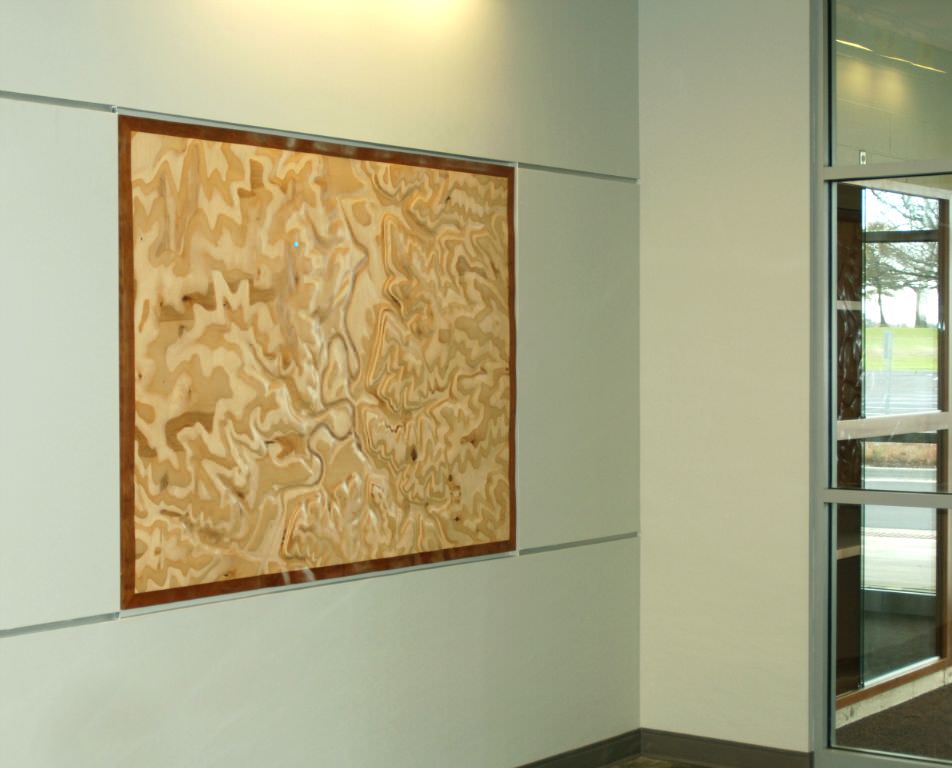
Common Ground: 6’ x 4’ 6” x 2” Baltic birch plywood, cherry wood trim, oil paints, conversion varnish, pulsing led light :: 2009.
This is a touchable, polished wood topography of the land on which the community center, park, and surrounding neighborhoods are located. These contours welcome the visitor as they arrive, and are an invitation to connect with the land through physical sensation.
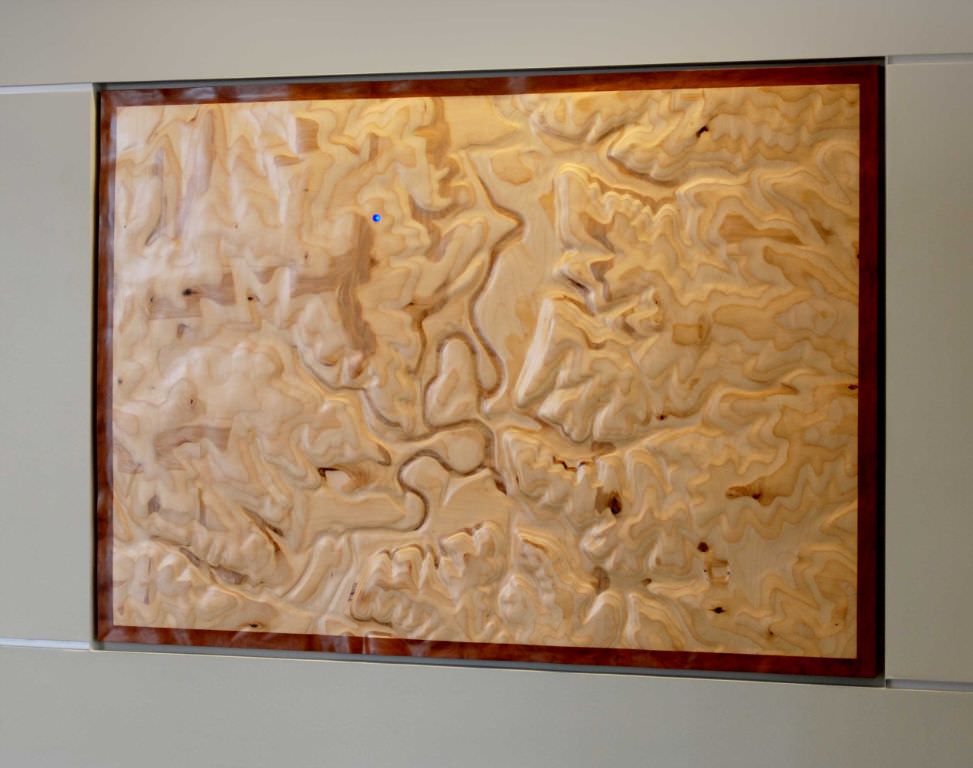
Common Ground: 6’ x 4’ 6” x 2” Baltic birch plywood, cherry wood trim, oil paints, conversion varnish, pulsing led light :: 2009.
The location of the Community Center is marked on the map by the slowly pulsing blue light, and this acts as an orientation point for visitors.
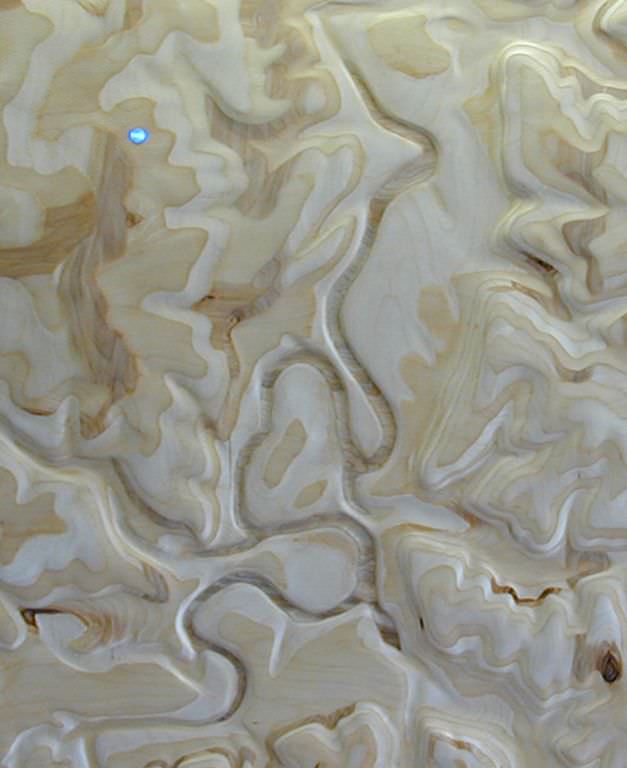
Common Ground: detail prior to varnishing :: 2009.
A close examination of the surface reveals that the Blue River valley has been painted in by hand to look almost exactly like the pattern generated by carving through the layers of plywood. It is hard to tell where the “natural” begins or ends.
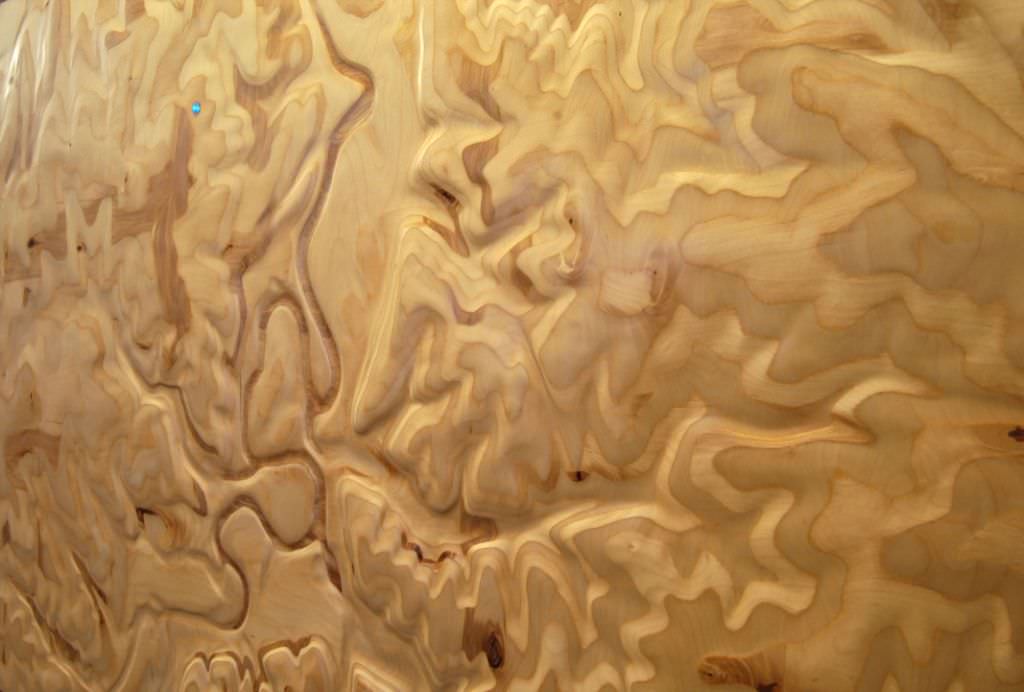
Common Ground: detail :: 2009.
We have seen Parks employees trace their daily journeys by running their hands over the surface of these contours.
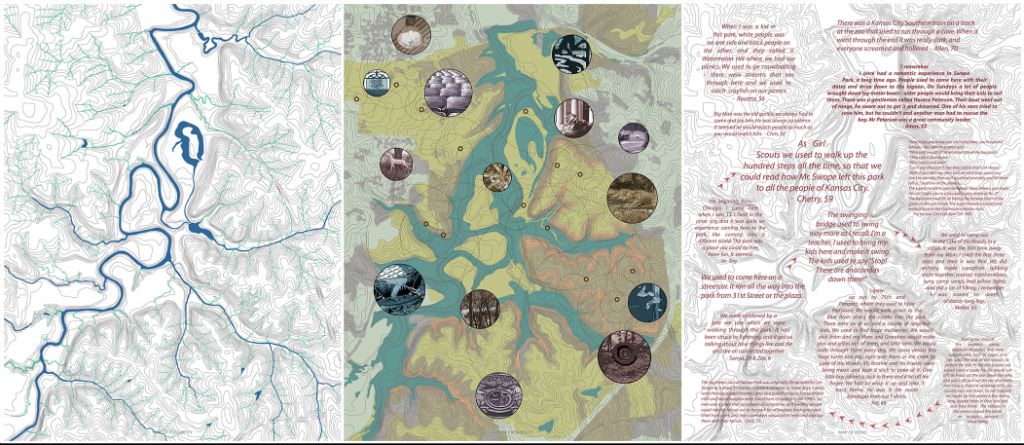
Mapping Community: Graphics of the Map of Possibility, Map of Probability, and Map of Being: Digital design for printing.
These are the digital designs for three maps that describe symbolic ways of connecting to this particular place and to the relationships that exist here.
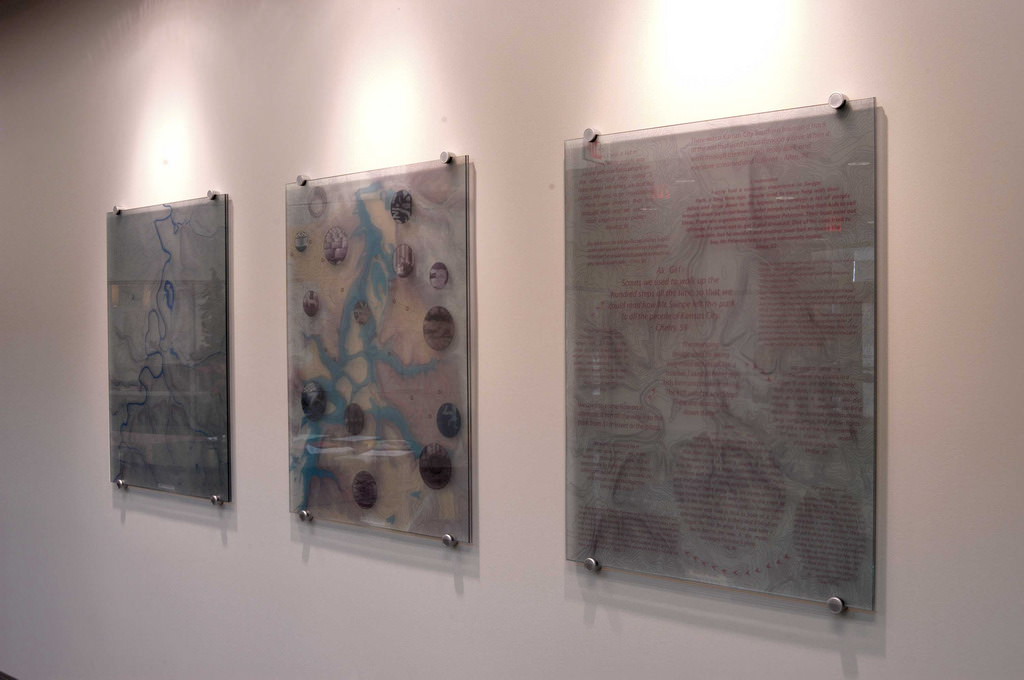
Mapping Community: Actual panels are 30” x 39”, and are composed of tempered glass, acrylic, double surface printing, metal stand offs :: 2009.
Because the actual maps are both translucent and reflective, they are quite difficult to photograph.
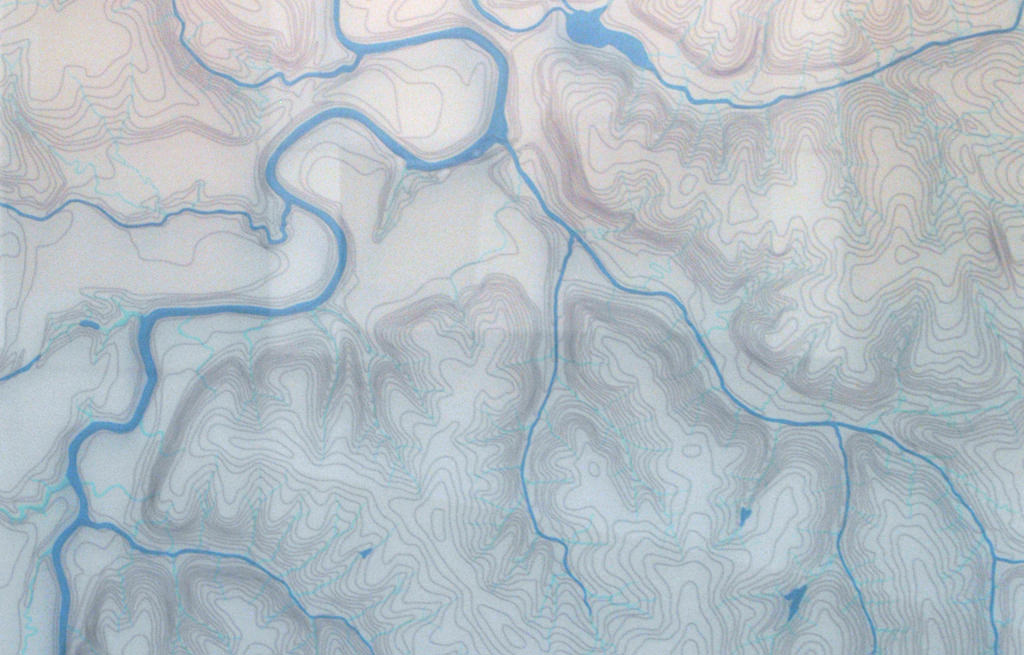
Map of Possibility (detail): 30” x 39”, tempered glass, acrylic, double surface printing, metal stand offs :: 2009.
The first panel is a mapping of the physical terrain, including actual and remembered water. There are many creeks, lakes and seasonal streams that once flowed across the surface of the land, shaping its gullies, slopes and valleys. The inland ocean made many of the rocks found in this region, and ice, wind and water turned them into proto-soils - forming the cradle for the complex web of that followed.
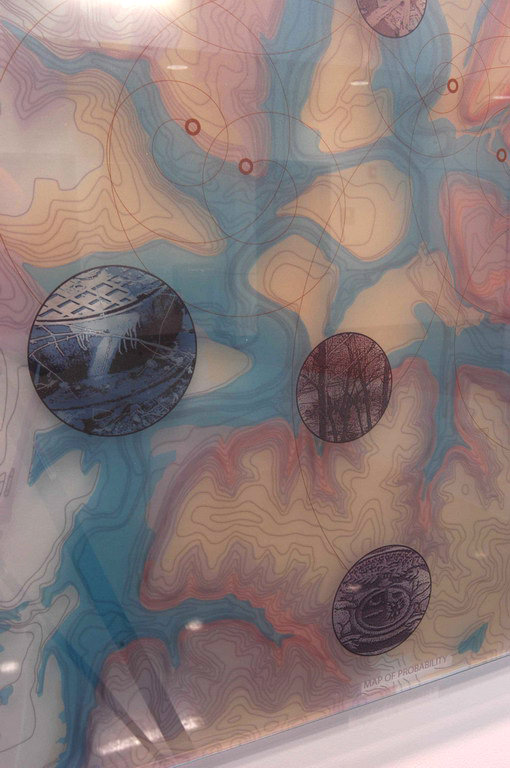
Map of Probability (detail): 30” x 39”, tempered glass, acrylic, double surface printing, metal stand offs :: 2009.
The second panel is a map of intervention by living beings, showing traces of flora, fauna and humankind. Information on the Map of Probability also links to two other sites in the installation – the Connection Web and Video Explorers.
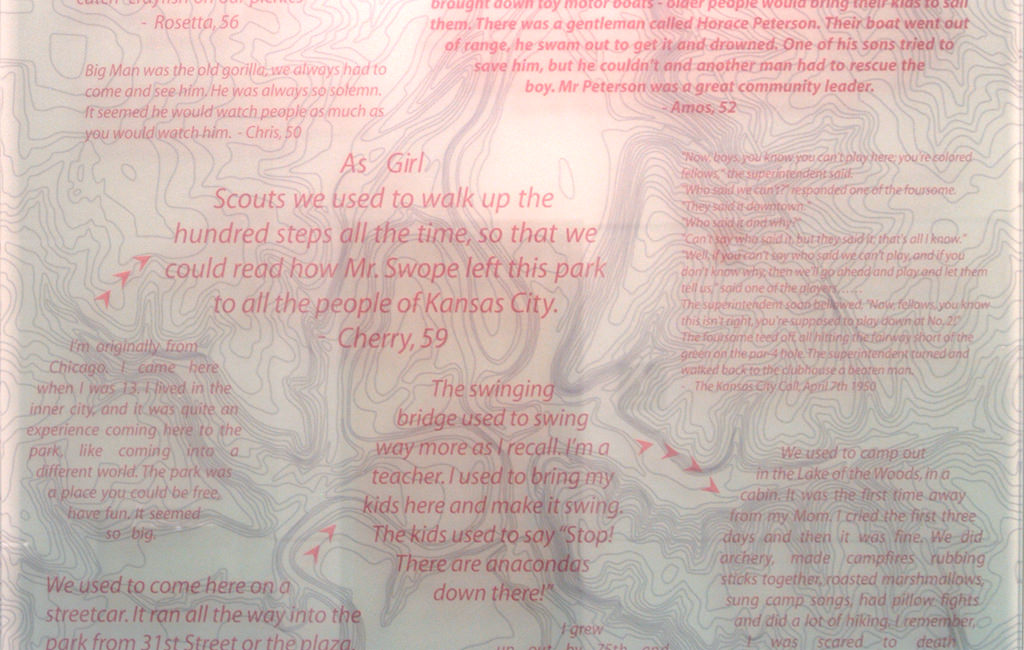
Map of Being (detail): 30” x 39” , tempered glass, acrylic, double surface printing, metal stand offs :: 2009.
The third panel is a memory map of gathered cultural experience. We interviewed people in Swope Park and gathered stories about their experiences connected with specific places around the park.
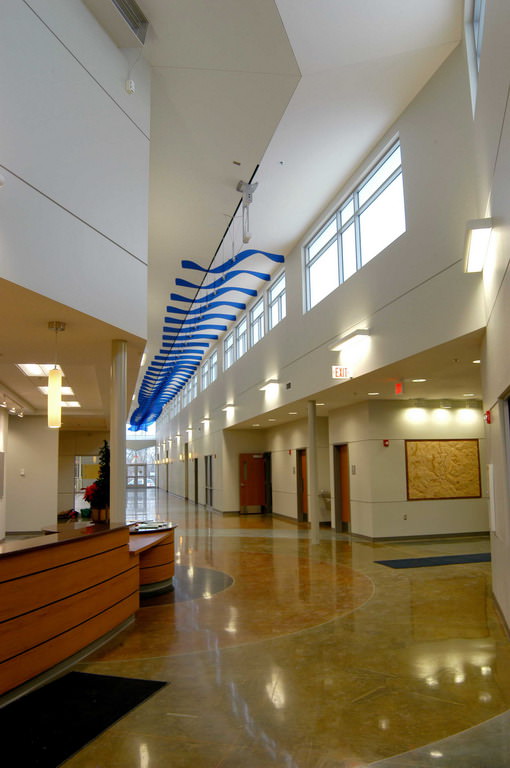
Main hallway inside the SECC showing Ripple Effect and Common Ground installations :: 2009.
The project as a whole has several layers of engagement, in that it is simultaneously intended for the community’s enjoyment, to be of use to the community, and to encourage the collaborative making of art by members of the community. The first goal was achieved by designing work that integrates sensitively into the welcoming spaces and environmental parameters of the building. We also created forms, surfaces and content that are accessible, engaging, and relevant to the users of the center. The remaining two criteria were driven by our understanding of community as a set of relationships, and the belief that participatory art programs can provide both seeds and tools for growth.

Ripple Effect: 3’ x 6’ x 150’ Acrylic fins, steel, aluminum, sensors, controllers and stepper motors :: 2009.
Metaphorically, this work relates to the powerful agency of an individual acting in community, a circumstance in which one person can create surprising and far-reaching effects.

Ripple Effect: 3’ x 6’ x 150’ Acrylic fins, steel, aluminum, sensors, controllers and stepper motors :: 2009.
Ripple Effect uses a principle of physics to propagate an initial twisting movement through a series of connected elements. This produces a rippling wave that travels down the entire length of the corridor.
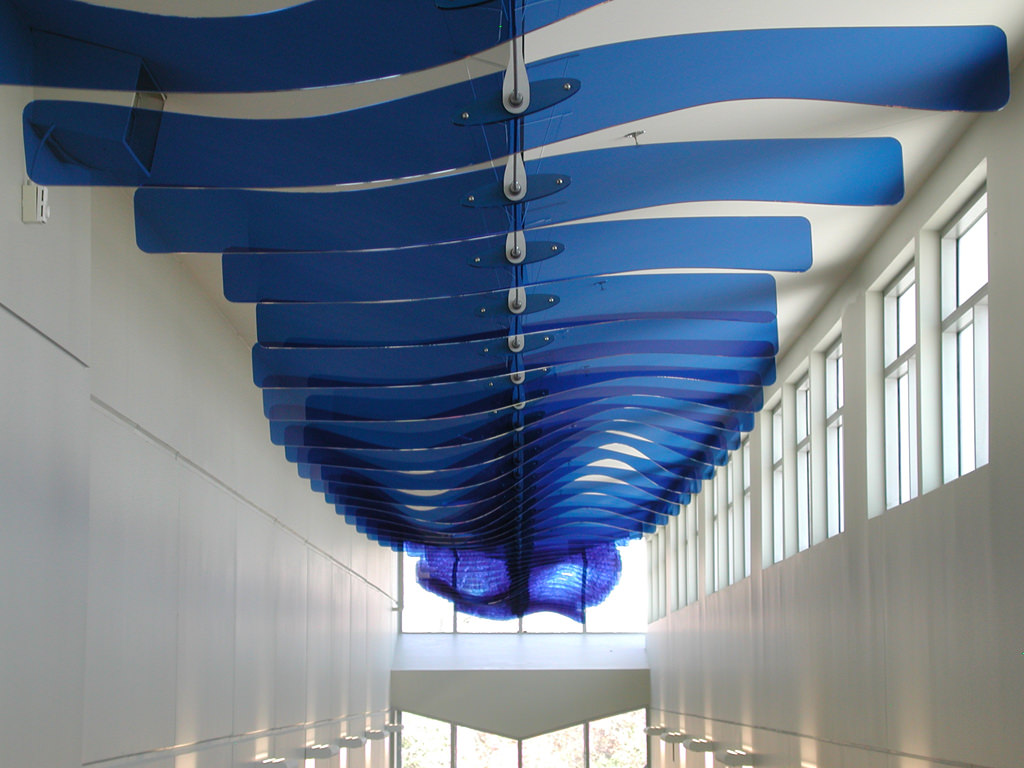
Ripple Effect: 3’ x 6’ x 150’ Acrylic fins, steel, aluminum, sensors, controllers and stepper motors :: 2009.
This sculpture uses two passive infrared motion sensors, one at either end of the installation, each of which is connected to a stepper motor. Waves can be generated from both ends simultaneously, and then pass through each other.
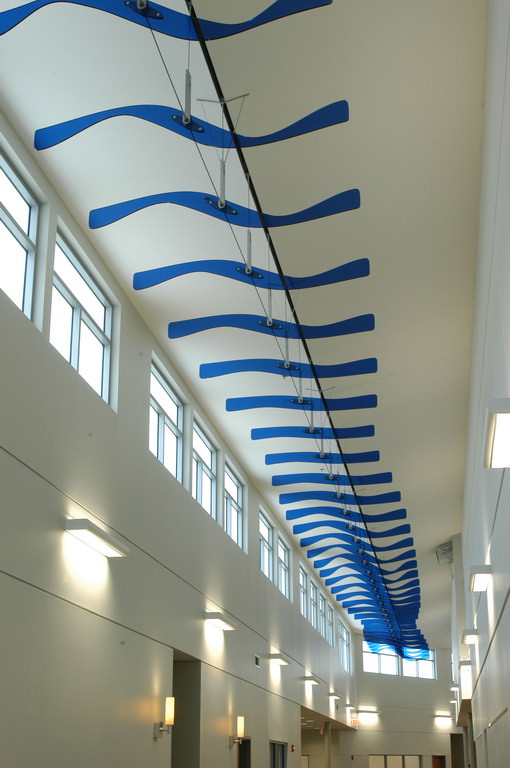
Ripple Effect: 3’ x 6’ x 150’ Acrylic fins, steel, aluminum, sensors, controllers and stepper motors :: 2009.
The form of Ripple Effect was partly inspired by learning about the massive, shallow inland sea that covered this area in geological history.
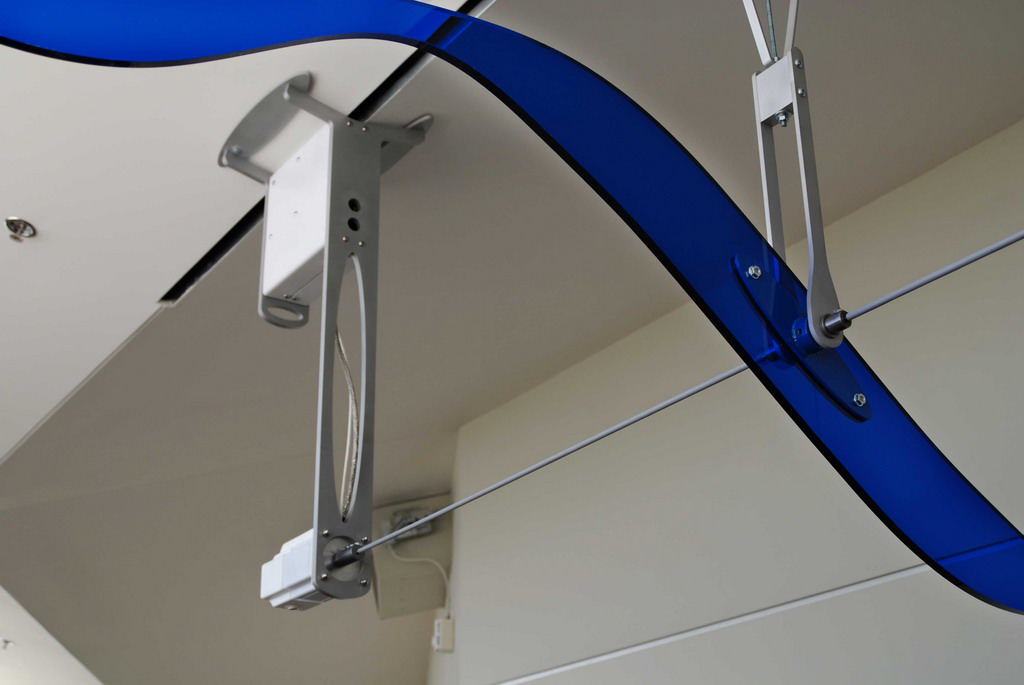
Ripple Effect: detail :: 2009.
When a sensor is triggered, the response is governed by a controller. This allows us to control the speed and amplitude of the initial torque, to implement a refractory period so that the system does not trigger too often when crowds are present, and to limit the movement so the fins do not hit the ceiling.
More construction details.
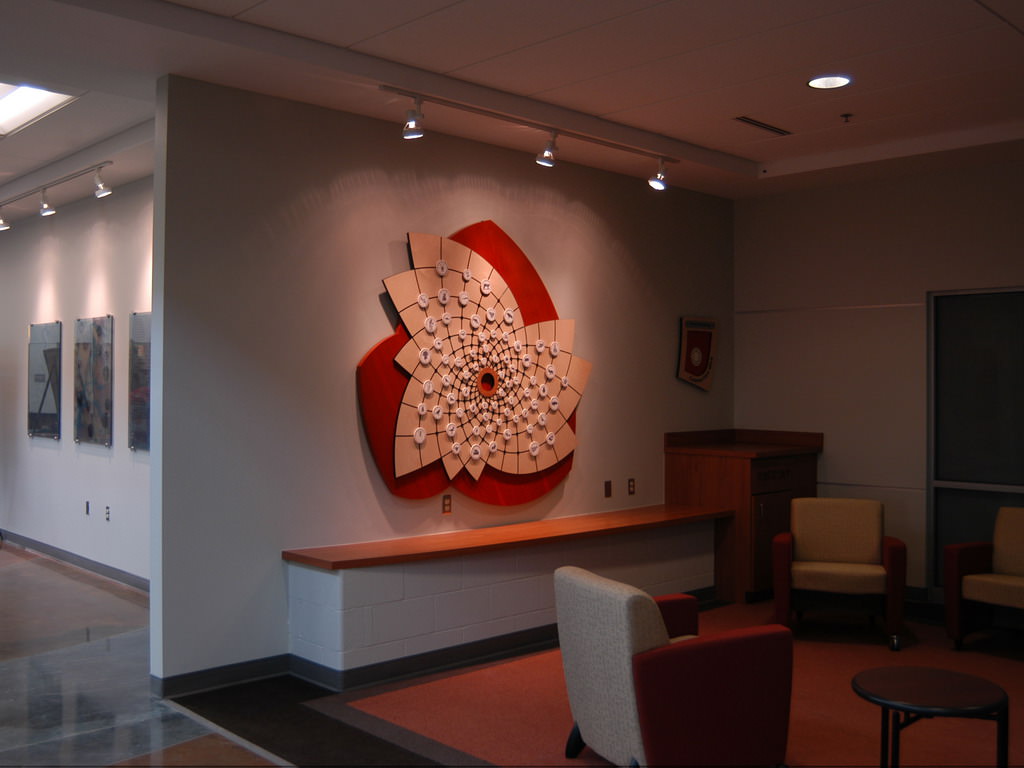
Connection Web: 6’ 4” x 5’ 9” x 2” Baltic birch and cherry wood ply, Delrin, aluminum, Corian, porcelain with decals, steel and polycarbonate locking mechanism :: 2009.
We placed this sculpture in a publicly accessible meeting and waiting area. It was designed to function in three different ways: To be visually intriguing (especially to children), to be an educational game, and to serve as an exhibition site for use by community members.
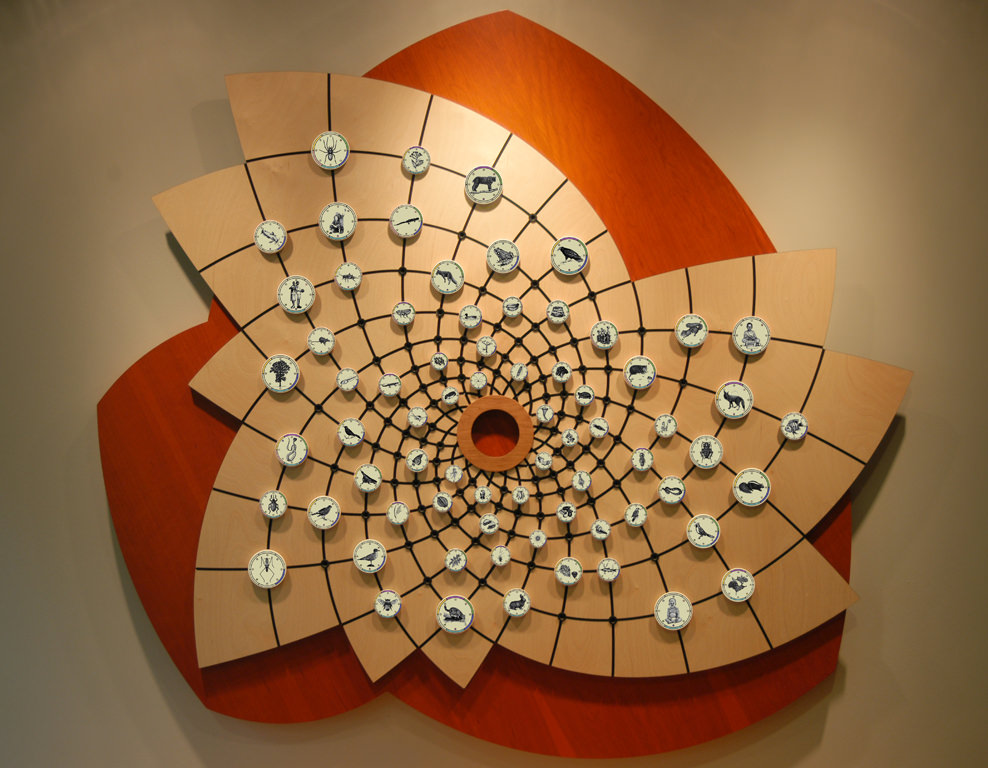
Connection Web: 6’ 4” x 5’ 9” x 2” Baltic birch and cherry wood ply, Delrin, aluminum, Corian, porcelain with decals, steel and polycarbonate locking mechanism :: 2009.
Connection Web is a display system that is studded with small porcelain tiles illustrating the interdependence of living creatures in an urban ecosystem. Each tile has a coding system on it, and kids can be detectives and find out where each specimen can be found, what it eats and what eats it.
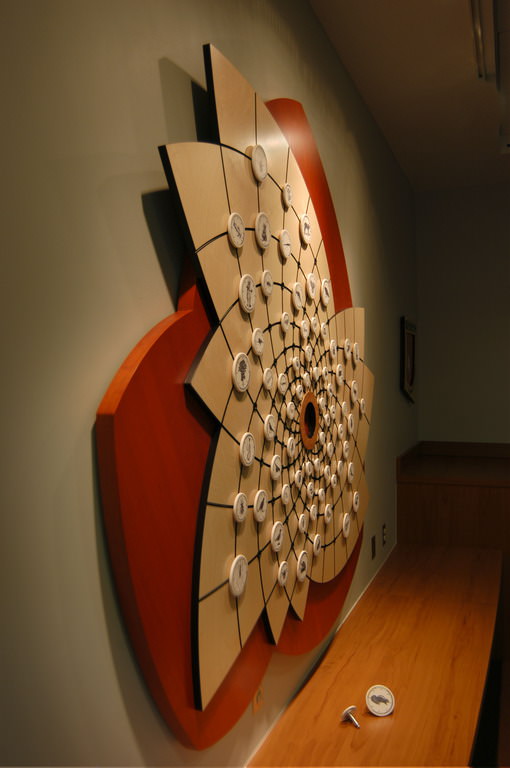
Connection Web: 6’ 4” x 5’ 9” x 2” Baltic birch and cherry wood ply, Delrin, aluminum, Corian, porcelain with decals, steel and polycarbonate locking mechanism :: 2009.
The board can be reconfigured to create an opportunity for temporary art shows by classes or community groups – for exhibiting drawings, clay tiles, photographs, quilt squares, short poems and so on. It has a simple locking mechanism for changing displays, and an ample supply of blank pegs for mounting and installing small objects.
[More construction details]
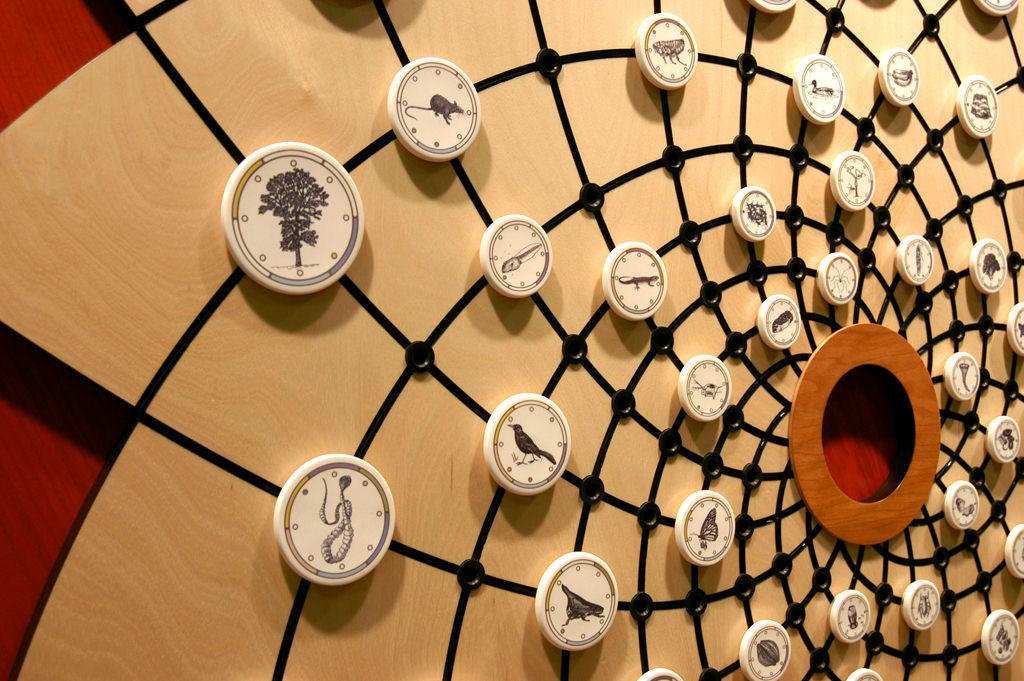
Connection Web: detail :: 2009.
The style of these drawings is based on the illustrations that might be found in a child’s encyclopedia or nature book. The colors around the outer circle indicate habitat, and the inner circle of dots show whether the plant or animal produces energy from the sun, or is some kind of a consumer – herbivore, carnivore, parasite, cannibal or scavenger.
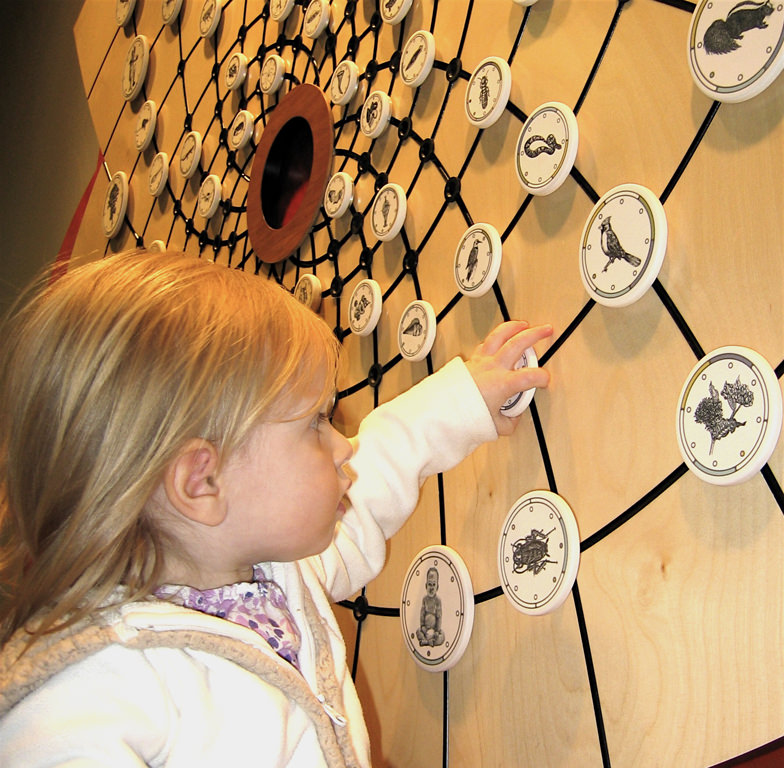
Connection Web: detail :: 2009.
The sturdy construction and easily cleanable materials mean that children can touch and twist the tiles while looking at the intricate drawings on them. The relative scale of the drawings is deliberately shifted, so as not to reinforce typical ideas of which living beings are the most important.
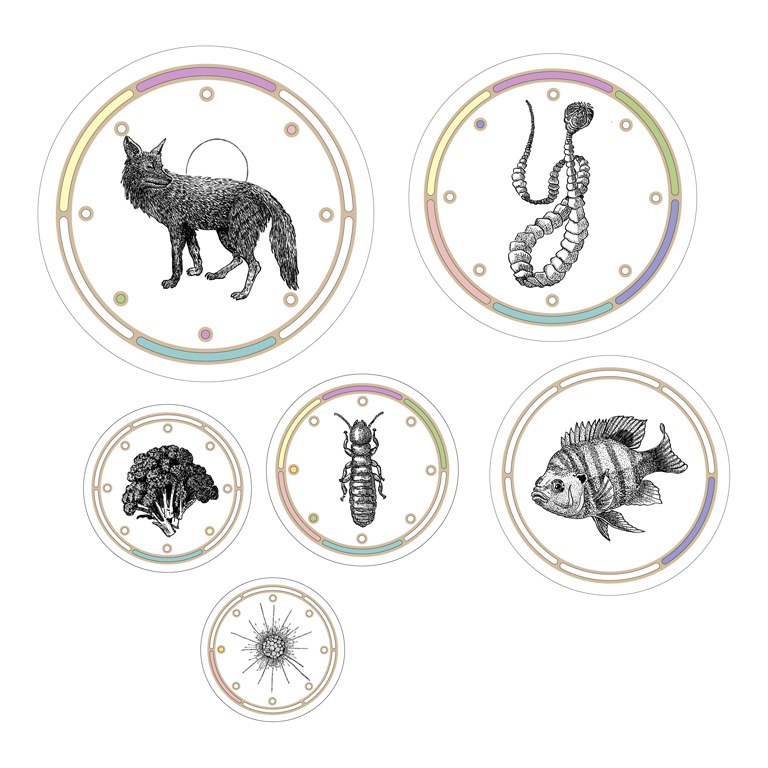
Connection Web: image samples for decal printing :: 2009.
The food web that is illustrated in this sculpture includes plants, animals, protists, fungi, people and human food. Shown here are a coyote, tapeworm, worker-termite, head of broccoli, bluegill and vampyrella. All the specimens can be found in or around Swope Park.
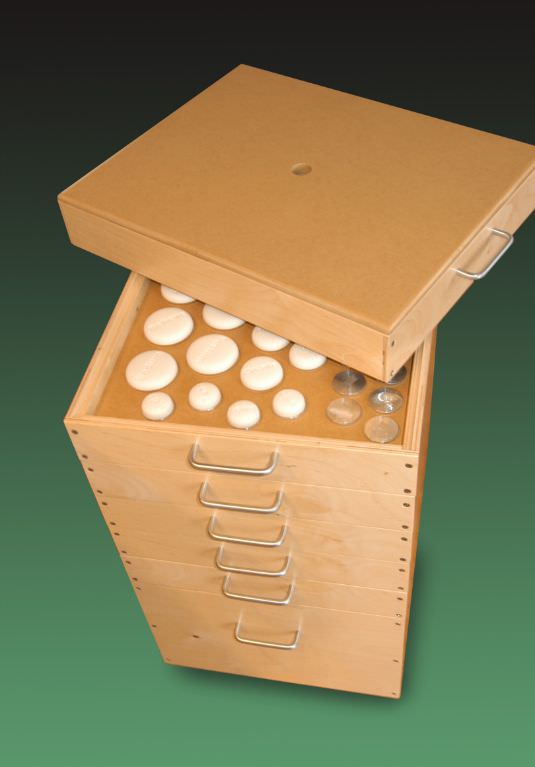
Connection Web Storage Cart: 30” x 16” x 20”, Baltic Birch plywood, MDF, wheels, hardware :: 2009.
This storage cabinet contains a set of text tiles that are carved with words describing actions that build relationship. We didn’t have any specific ideas about how the text tiles would be used, but thought that they might inspire discussion, or perhaps be used as themes for shows of work. The cabinet also has shelves for storing the food web tiles if they are removed for an installation, extra pegs for mounting work for exhibition, and materials connected to the teaching game.
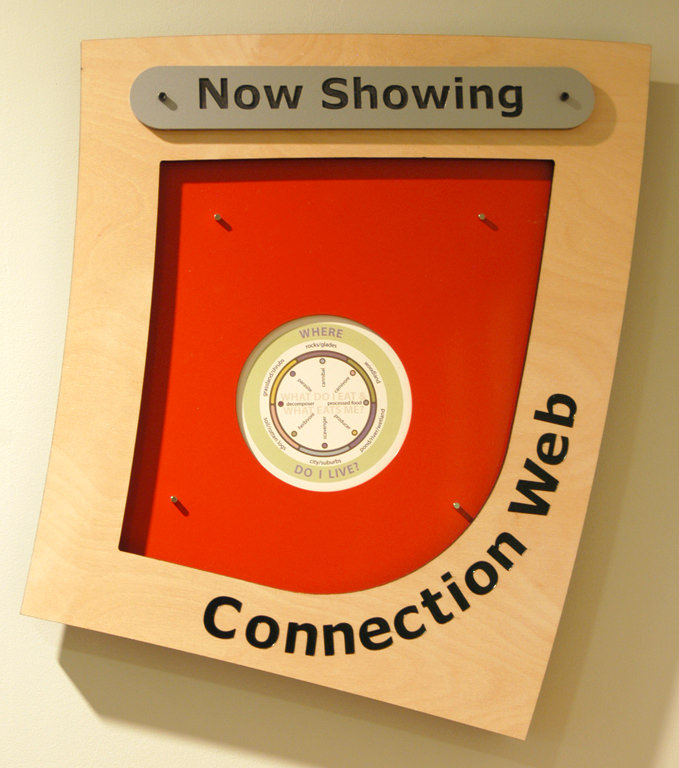
Connection Web Next Show Board: 18” x 24” x 1” Baltic birch plywood, powder-coated steel, paint and dibond :: 2009.
We made this board as a place to find further information about whatever is on the Connection Web. The “Now Showing” sign flips over to read “Next Show”, and flyers and other materials can be attached to the steel plate with magnets. When the food web is on display, the central image contains the information necessary to decipher the codes on each tile.
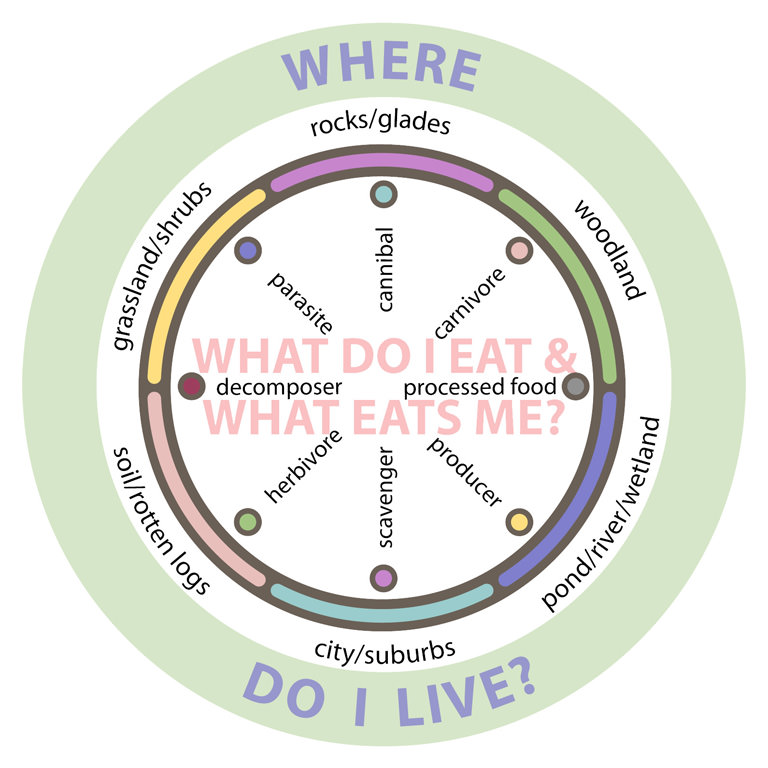
Connection Web: 8” x 8". Clay tile, glaze, decal :: 2009.
This is the key for deciphering the food web codes. The colors connected with each of the habitat zones are the same as the ones used on the Map of Probability. This means that once a kid has identified the kind of place where a specimen lives, they can then go and locate an area on the map where they could look for it. The storage box contains a couple of charts for teachers, to help children identify each plant or animal by name from its habitat and dietary relationship.
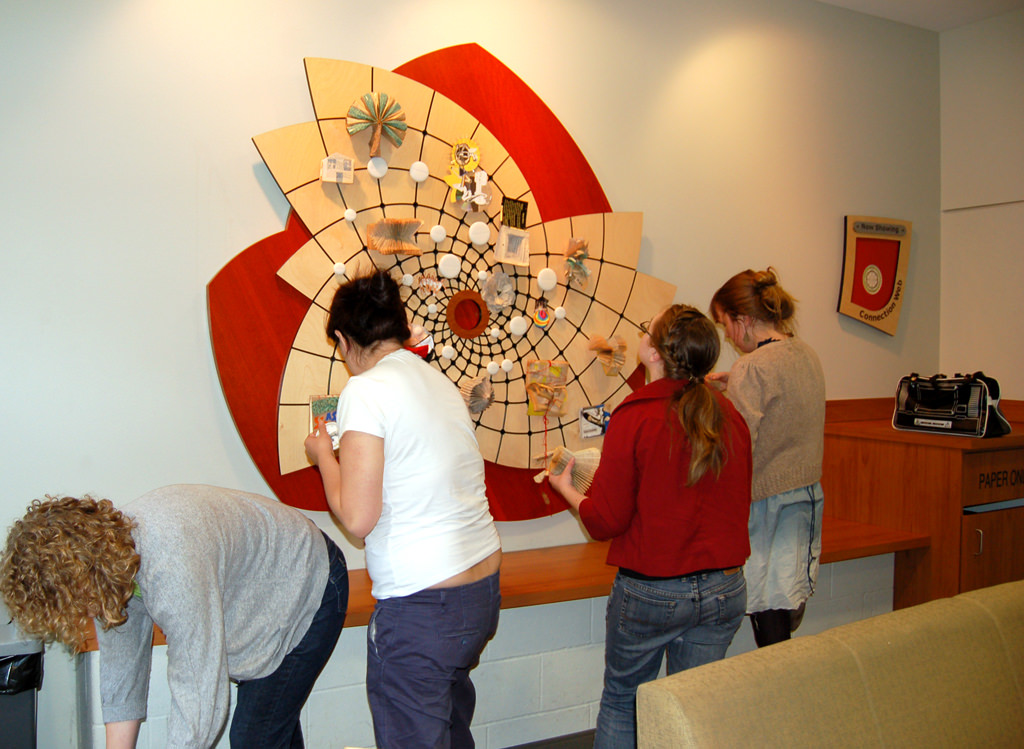
Connection Web: 6’ 4” x 5’ 9” x 2” Baltic birch and cherry wood ply, Delrin, aluminum, Corian, porcelain with decals, steel and polycarbonate locking mechanism :: 2009.
As part of our commitment to the community center, we set up a teaching internship program, in partnership with the Parks Department, that trains students from a local art college to teach classes in a community context. The classes use the facilities located at the center. This image shows student interns reconfiguring the display to exhibit artwork made in classes they taught at the SECC.
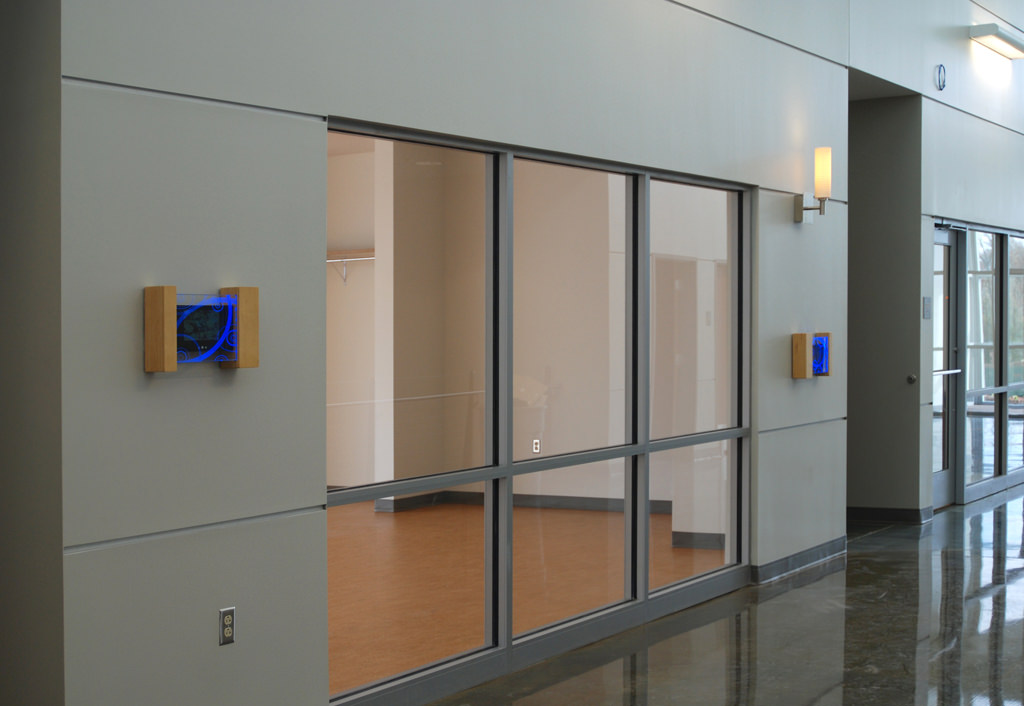
Hallway inside the SECC showing location of Video Explorers :: 2009.
Similarly to the Connection Web, the Video Explorers installation was designed to function both as a complete artwork and as an exhibition venue for videos made by members of the community. The two players were placed at different heights to appeal more to teens or to younger children.
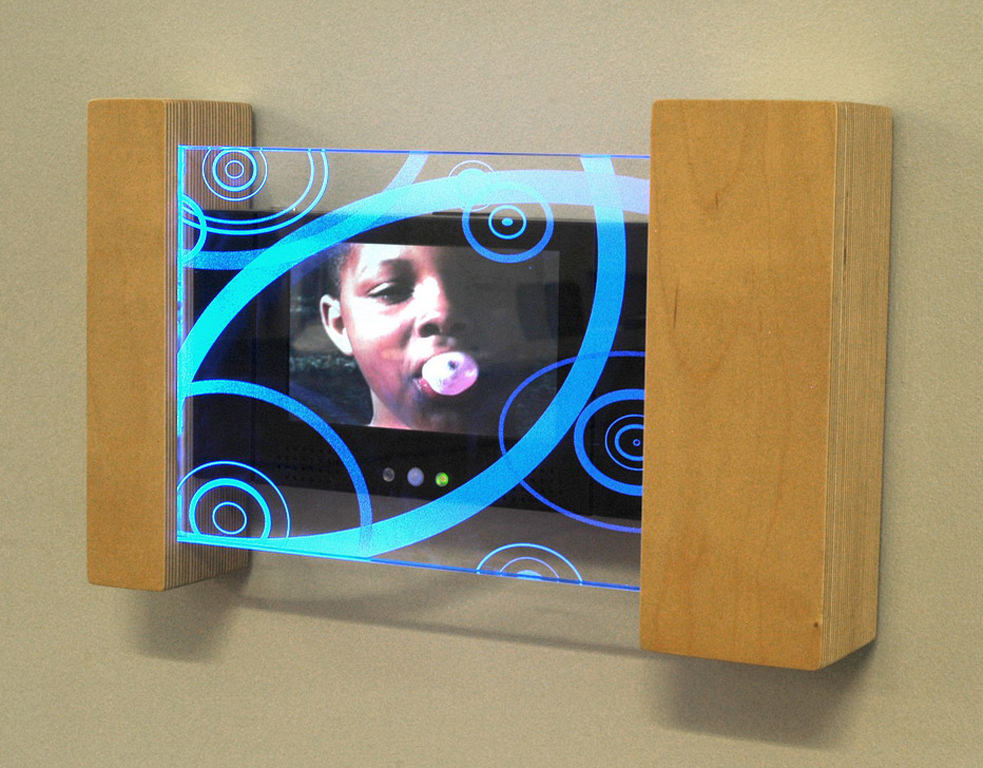
Video Explorers: 1’ 4” x 10” x 3” Baltic birch ply, etched tempered glass, led edge light, solid state media player :: 2009.
Each digital video station was supplied by us with silent video loops of natural and urban communities we discovered during our extensive explorations of Swope Park.
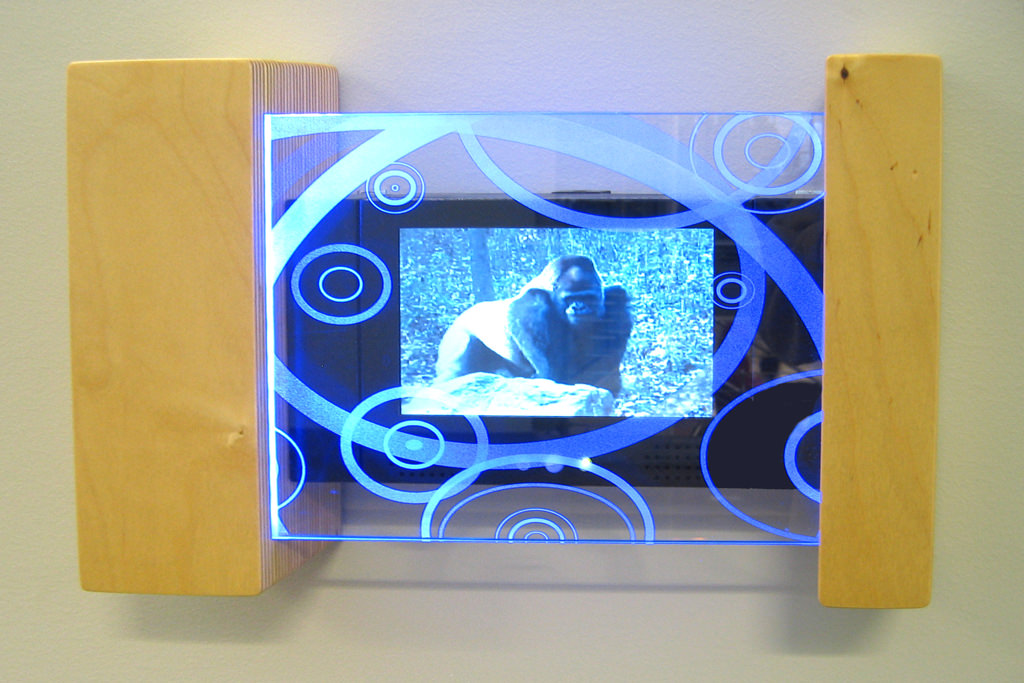
Video Explorers: 1’ 4” x 10” x 3” Baltic birch ply, etched tempered glass, led edge light, solid state media player :: 2009.
The sequences we supplied contain footage from the zoo, sports facilities, nature trails, mounted police stables, family picnics, festivals, park monuments and so on, edited in a way that we hoped would inspire kids and teens to make their own movies.
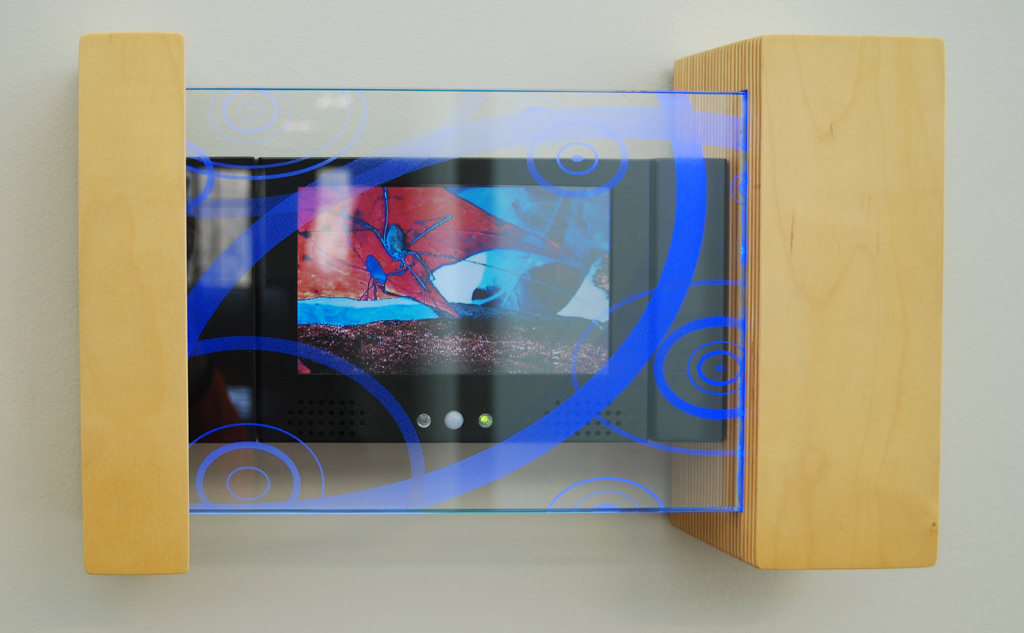
Video Explorers: 1’ 4” x 10” x 3” Baltic birch ply, etched tempered glass, led edge light, solid state media player :: 2009.
Each player contains footage that was composed specifically for its intended target audience. One sequence for the younger children, called "Explore", shows footage of unusual locations we discovered while doing research in Swope Park. Still frames at the end of each portion link to the images on the Map of Probability, so that kids can go and look for the places themselves.
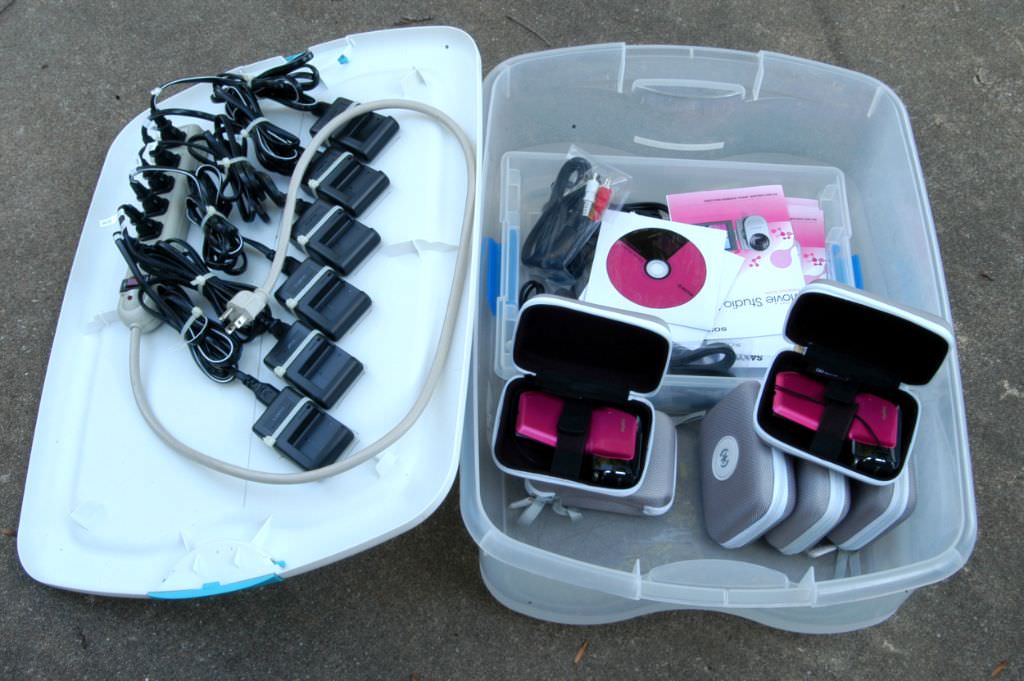
Cameras and software purchased for the community center for programming with the Video Explorers :: 2009.
As part of the long-term development of the project, we purchased six digital video cameras (inexpensive models), flash card storage and editing software, providing tools for a hands-on, continuing class for kids and teens to learn technology skills and explore their surrounding environment. We believe that the linking of public programming to public artwork models a way in which closer, mutually beneficial relationships between artists and their community can be created.

X-acti HD digital video and still camera model :: 2009.
Simple editing can be done in the new computer room on site, and flash card storage means that exhibitions of work made by community members can be quickly and easily installed on the Video Explorer units. The Community Center is now also able to use the screens to display footage of their events, award ceremonies and activities, enabling community members to celebrate and share cultural activities.


